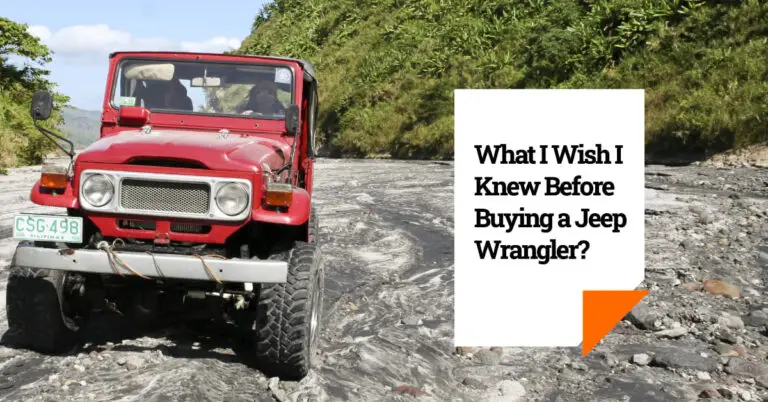How To Improve Your Jeep Wrangler’s Ride Quality?

The short answer: Install upgraded shocks and springs, lift kit, larger tires, and adjust tire pressure to smooth out the bumps and improve ride comfort in your Jeep Wrangler.
As any Jeep Wrangler owner knows, these iconic off-road vehicles deliver unmatched capability over rocks, trails, mud and more. But the rugged solid axles and suspension that enable the Jeep Wrangler’s legendary performance off-road can make for a stiff, bumpy ride when driving on paved roads.
If you find your Jeep Wrangler to be uncomfortably stiff and bouncy on the street, there are several upgrades you can make to improve ride quality and comfort without sacrificing off-road prowess. This article will cover:
- Evaluating your current suspension system
- Shock and strut upgrades for better ride quality
- The benefits of installing larger tires and wheels
- Proper tire inflation for improving ride comfort
- Lift kits that can enhance on-road performance
- Alignment considerations after suspension work
Follow these tips to make your Jeep Wrangler more comfortable for daily driving while maintaining its rugged off-road capabilities.
Table of Contents
Start By Evaluating Your Current Suspension System
The first step in improving your Jeep Wrangler’s ride quality is to thoroughly inspect the current suspension components. Look for any signs of wear and tear that could be contributing to a rougher, less comfortable ride.
Inspect Your Shocks and Struts
The shocks and struts are one of the most important parts of your suspension when it comes to ride comfort. If your shocks are worn out, they won’t be able to dampen impacts from bumps and dips in the road effectively. This translates into a bouncy ride.
Check your shocks and struts for any exterior damage or leaks. Oil leakage around the shaft is a telltale sign that the internal seals are worn out, preventing the shock from dampening properly. If you spot any damaged, dented or leaking shocks, replacement should be a top priority.
Check Your Suspension Springs
The springs are what support your Jeep Wrangler’s weight and allow the suspension to compress and rebound when going over uneven terrain. So worn out springs will detrimentally affect ride quality.
Inspect your springs closely for any cracks, damage or sagging. Lowered ride height in the front or back can indicate sagging springs that need to be replaced. Any compromised springs should be swapped out right away.
Upgraded performance springs can also help improve ride quality by providing firmer support and better handling. More on suspension upgrades coming up next.
Consider Replacing Entire Suspension System
If your Jeep has especially high mileage or signs of excessive suspension wear, you may want to replace the entire suspension system with heavy duty components. This includes the shocks or struts, springs, control arms, track bars, sway bars and more.
Upgraded suspension systems are available from companies like Rocky Road Outfitters, Teraflex and Rubicon Express. We’ll cover the benefits of these suspension lift kits later on.
Now let’s get into specific upgrades that can improve your Jeep’s ride quality when driving on pavement.
Upgrade to Heavy Duty Shocks and Struts
One of the single best upgrades for improving ride comfort in your Jeep is installing high-performance shocks and struts. Here’s what to look for:
Go With Monotube Shocks
For optimal ride quality, upgrade to monotube shocks from reputable brands like Bilstein, Fox Racing Shox or Rancho. In a monotube design, the oil and gas are separated into two chambers which prevents aeration. This allows them to resist fading and maintain consistent dampening control.
Dual-tube shocks are more prone to performance degradation since the oil and gas mix together leading to fading and inconsistent dampening forces.
Choose a Firm, Performance Valving
Look for shocks engineered specifically to provide a smoother on-road ride while still tackling off-road conditions. Bilstein 5100 series and Rancho 9000XL shocks are great options.
The 5100’s have a unique valving and firm rebound tuning to smooth out bumps. For even greater handling, look for adjustable models like the Bilstein 5160s.
Go Heavy Duty if Towing or Hauling
Do you regularly haul heavy gear or tow trailers with your Jeep Wrangler? Then be sure to upgrade to extra heavy duty shocks rated for your load capacity.
Bilstein makes shocks engineered specifically for towing in Jeep Wranglers that provide stability and control when loaded down. This prevents the back end from sagging and improves ride comfort.
The right shocks and struts make a world of difference in smoothing out your Jeep’s ride. Next let’s discuss why larger tires can enhance your on-road cruising comfort.
Install Larger Tires and Wheels
The Jeep Wrangler comes standard with 17 inch wheels and relatively small 255/75R17 or 255/70R18 tires from the factory. While these diminutive tires work great off-road, they don’t do much to smooth out bumps and dips on the highway.
Upgrading to larger diameter tires can dramatically improve your ride quality on pavement. Here’s why bigger is better for on-road comfort:
Larger Tires Absorb More Shock
Taller tires with a taller sidewall naturally absorb and dampen impacts from the road better than short, stiff sidewalls. More flex and cushion from the tire equals a softer, smoother ride over bumps.
Higher Sidewalls Provide More Comfort
In addition to the larger diameter, upgrading to taller sidewalls adds more air volume for a cushier ride. More sidewall flex acts like having more air in the tire, smoothing out the ride.
Superior Handling and Grip
Larger diameter tires combined with a wider tread enhance handling, cornering grip, braking performance and overall control. Better grip and composure at speed makes for a more stable, comfortable ride.
Recommended Upgrades for Street Comfort
What size tires should you upgrade to for improving ride quality? Here are some recommended upgrades:
- 32 inch tires minimize impact on gearing while adding comfort
- 33 or 35 inch tires offer a nice balance of size, cushion, and performance
- 37 inch tires provide maximum air volume and smoothing capability
Just keep in mind that going too large will adversely affect acceleration and economy. Stick to no more than 37 inch tires for a street-driven Wrangler.
Now let’s discuss wheel upgrades to go along with those larger tires.
Get Wheels With More Backspacing
When upgrading wheel size, pay attention to the backspacing measurement. This is the distance between the wheel mounting surface and the inside edge.
More backspacing pushes the tires outward, providing greater clearance from the suspension components so larger tires don’t rub at full compression off-road.
Look for at least 4.5 inches of backspacing if upgrading to 35″ or larger tires. Popular wheels like Pro Comp and Fuel have higher backspacing options.
Cushier, higher volume tires are key for a more comfortable ride. Next let’s go over proper inflation pressures.
Adjust Tire Pressure For Max Comfort
Running your Jeep Wrangler’s tires at the correct pressure not only improves tread life and handling, but also enhances ride quality. Here are some tips:
Check Your Owner’s Manual
Consult your owner’s manual or door placard sticker for the factory recommended tire pressure range for your Jeep. This is a good starting point.
Consider Running Near Max Pressure
For highway driving and improved ride smoothness, consider inflating near the maximum pressure listed. Higher pressures minimize sidewall flexing for a firmer, more stable ride.
Check Pressures When Tires Are Cold
Always check and adjust air pressure when the tires are cold, meaning before you’ve driven or sat in direct sun. Tires heat up and pressure increases as you drive.
Invest in an Accurate Gauge
Don’t rely on gas station air pumps which are often inaccurate. Use a quality dial or digital tire gauge for precision inflation.
Proper inflation is key to maximizing your tires’ comfort and longevity. Now let’s go over how a suspension lift kit can improve ride quality.
Consider Installing a Suspension Lift Kit
One way to significantly enhance your Jeep Wrangler’s ride comfort is adding a suspension lift kit. Kits from 2 to 3 inches are ideal for improving on-road performance.
Here are some benefits of installing a small lift on your Wrangler:
Allows for Larger Tires
A lift kit raises the suspension to make room for installing those larger, cushier tires we discussed earlier. It allows you to run 35s or even 37s while maintaining clearance off-road.
Improves Articulation and Flex
By raising the suspension and allowing more droop travel, a lift kit enhances articulation over uneven terrain. This also translates into a smoother ride over paved bumps and dips.
Reduces Body Roll
A lift kit can come with stiffer sway bars and suspension components that reduce body lean when cornering, improving handling and stability on pavement.
Levels Out Ride Height
A subtle 2.5 inch lift can level out the Jeep’s stance if sagging in the rear from age or heavy use. This prevents a tail-dragging rake.
Recommended Lift Brands and Kits
Highly rated suspension lift kits for improving comfort while retaining off-road performance include:
- Rocky Road Outfitters 2.5″ lift ideal for 32-35″ tires
- Teraflex 2.5″ lift with strong springs and shock mounts
- Rubicon Express 2.5″ kit includes monotube shock upgrade
For maximum clearance to run 37s, the Teraflex 3.5″ kit is a great choice to improve on-road ride as well.
Installing a lift kit can work wonders for ride quality, provided you get a proper alignment done after installation.
Don’t Forget a Post-Install Alignment
Once you’ve upgraded your Jeep Wrangler’s suspension and tires, it’s critical to get a professional alignment done. Here’s why:
Lifts Can Alter Suspension Geometry
Even a 2 inch lift slightly changes the suspension’s alignment angles. A good alignment restores proper toe, camber and caster settings.
New Tires Can Change Things
Transitioning to taller tires with a larger circumference alters your Jeep’s alignment. An alignment ensures proper steering and handling.
Avoid Uneven Tire Wear
Daily driving on misaligned wheels will cause uneven, rapid tire wear. A post-install alignment prevents this costly damage.
Restores Straight Line Tracking
Proper alignment eliminates pulling, wandering and uneven steering effort for straight line stability at speed.
Don’t skip this important step after suspension work or new tires to ensure safe handling and maximum comfort.
Enjoy Improved Daily Driveability
Getting your Jeep Wrangler to ride smoothly on the highway while retaining off-road capability is achievable with the right upgrades. Start by inspecting your suspension components like shocks and springs for any needed replacement parts.
Upgrading to heavy duty monotube shocks makes a huge difference in controlling impacts from the road. Go larger on your tires and wheels for naturally smoother ride quality from the added air volume. Keep them properly inflated when street driving as well.
Consider lifting your Wrangler 2-3 inches to allow bigger tires, improve articulation and reduce body roll. Top it all off with a professional alignment.
Follow these tips to make your Jeep Wrangler more comfortable for daily driving while maintaining its legendary off-road performance. The ride doesn’t have to be rough when you upgrade key components. Now you can cruise the pavement in cushioned comfort without sacrificing capability over the rocks.







